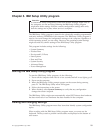Fixed-Disk Tests:
v Seek Tests - checks the physical operation of the drive head.
– Linear Seek
– Random Seek
– Min-Max Seek
– Butterfly Seek
v
Verify Tests - checks the integrity of the data present on the media.
– Linear Verify
– Random Verify
v
Surface Scan Tests - checks the drive media for defects.
– Surface Scan (Linear)
– Surface Scan (Aggressive) - this is disabled for normal customer use.
– Surface Scan (Random)
v SMART - checks the SMART functionality for drives that support SMART.
– Start SMART Self-Test
– Get SMART test results
Other
Test Features:
v Write-Splice Repair - detects and corrects Error Correction Code errors during
Verify tests.
v Auto Spin Down - a gradual spin down of the drive platters to avoid damaging
the media.
v Manufacturer Log - an in-depth manufacturer supported log of errors on the
drive.
Multitasking:
To allow simultaneous testing of multiple hard drives whenever possible, the
FDAT module is written as a set of multitasking functions. Each drive under test
can run the same test or run a different test at the same time. Each subtest is
written to handle a single test pass and all test variables are kept track of in a
structure unique for each drive. However, when testing IDE drives, FDAT will not
perform simultaneous testing of IDE drives that are attached to the same IDE
cable. For example, if FDAT is testing four IDE drives on a PC, it will perform
simultaneous testing on drives 1 and 3 first (master drives), then perform tests on
2 and 4 (slave drives). FDAT will also perform simultaneous testing on a master
and slave that are on separate IDE cables, but will not perform simultaneous tests
on a master and slave on the same IDE cable. This generally increases the amount
of time needed to test multiple IDE drives.
Another limitation of FDAT’S multitasking capability is the use of Ultra DMA
(UDMA). Only one drive at a time can access the UDMA channel and the UDMA
channel buffer must be kept high in order to maintain a speed advantage over
other data transfer modes. In order to use the UDMA channel during testing, users
must disable the multitasking feature.
Destructive vs non-destructive testing:
Most of the tests found in FDAT are non-destructive. This means that PCDR will
preserve any data that is present on the tested media prior to beginning any
destructive operations (i.e. write operations). However, users can run certain tests
Chapter 4. IBM Enhanced Diagnostics 17


















